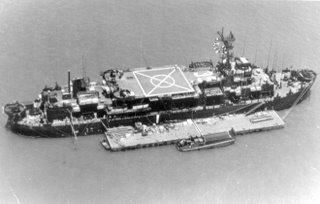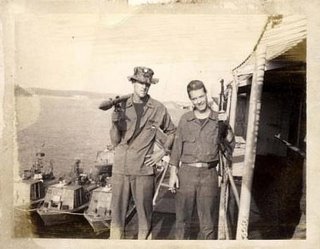
Somewhere in my past I spied the USS Benewah (APB-35) and thought her to be an ugly little ship. But that was before I learned more of the history of this "Battling Barracks Barge"...
The Navy built and used several types of barracks barges over the years, some self-propelled and others towed into place. In choosing to focus on a single unit no slight is intended to others ships and crews who served their country well and honorably. But choose I must, and I was vaguely familiar with USS Benewah, so this Sunday Ship History focuses on her.
Benewah started out on the planning board with the flat-bottomed hull of an LST (Landing Ship, Tank). The LST concept is said to have started with Winston Churchill. Benewah's official history does not refer to the inventor of the concept of the "Barracks Barge, Self-Propelled." Commissioned in 1946, too late for WWII, Benewah, served only a few months before being decommissioned herself. Her role, as might be gathered from her name, was to serve as living quarters for crews of ships and boats that, for a variety of reasons, could not stay on their own vessels. She was brought back to life in 1952, and deployed to the Mediterranean providing berthing for SeaBees. In 1953, Benewah became a flagship - for Commander, Fleet Air, Eastern Atlantic and Mediterranean, a role she played for a couple of years.
Soon laid up again, Benewah was brought back for use as berthing for precommissioning crews. But in 1967, Benewah joined the fighting Navy:
Following a week of training at the Naval Amphibious Base, Little Creek, Va., the ship put to sea for the Far East. After stops at Rodman in the Canal Zone and at Pearl Harbor, Benewah reached Vietnam on 22 April. Upon arrival, she became flagship for the Commander, Task Force (TF) 117, the Mobile Riverine Force operating in the Mekong Delta. Except for an occasional trip to Japan for repairs, Benewah spent the next 44 months at various locations in the Mekong Delta. In addition to serving as headquarters, she provided barracks space, medical facilities, stores issue, and a myriad of other services to the sailors and soldiers operating with the Mobile Riverine Force and with the similar formations that succeeded that organization when it was disestablished late in August of 1968. The barracks ship frequently suffered enemy fire, and her guns went into action on numerous occasions. In May and early June of 1970, Benewah participated in the incursion into Cambodian territory to support forces interdicting the Viet Cong supply lines running through that country.Much more on her Vietnam service is told here, at a website devoted to her Vietnam service with the Mobile Riverine Force . How well did she serve? A list of her awards gives some indication:
She received many awards and decorations for her Vietnam service: the Vietnam Service Medal; Vietnam Campaign Medal; three Presidential Unit Citations; four Navy Unit Commendations; four Meritorious Unit Commendations; three Republic of Vietnam Presidential Unit Citations; and the Republic of Vietnam Unit Gallantry Citation. In addition, she earned fourteen Battle Stars for her service "in country" Vietnam, making her one of the most decorated ships of the Vietnam War.Not to mention the Combat Action Ribbon...

Additional information here at the Mobile Riverine Force website:

Although she was obviously not a candidate for cruiser or destroyer duty, she was a far cry from the commissioned in 1946. An APB’s original armament consisted of two 20 millimeter gun mounts. In 1967, Benewah was outfitted with two quad-barreled 40 millimeter mounts, two 3’/50 installations and 20 strategically placed 50 and 30 caliber machine guns. In addition, she was equipped with 25 fiberglass assault boats, which were utilized by Army troops who made her their base of operations. A large helicopter landing platform was also built over her superstructure which was used for deploying troops and receiving casualties.Heck, even John F. Kerry spent some time on an APB (shown with Willam Rood. Kerry has the RPG launcher).
***
She became the Flagship for Commander, River Assault Flotilla One, Mobile Riverine Force Task Force-117 and Commander, 2nd Brigade, 9th Infantry Division. After a short stay in Vung Tau, the Benewah moved up river and began a series of combat riverine assault operations in the Mekong Delta. When the Navy Boat Crews and the Riverine Infantry embarked, the ship’s company increased from 160 to 1150 personnel on board. She participated in all Coronado Operations from I-XI, and played a large role during the TET offensive in 1968, moving from one spot to another. The 10,000th helicopter landing was made on her deck in the Fall of 1968 by the 9th Aviation Battalion.
***
Though the Benewah was the first "Green Ship" to serve in the Mekong Delta, as part of the Mobile Riverine Force, she wasn't alone. There were three more APB's - USS Colleton (APB-36), USS Mercer (APB-39) and USS Nueces (APB-40). There were 5 ARL's - USS Satyr (ARL-23), USS Sphinx (ARL-24), USS Askari (ARL-30), USS Indra (ARL-37) and USS Krishna (ARL-38) and many APL's and YRBM's. (quoted from Albert Moore at MRFA site)
 Nice bit of oral history here:
Nice bit of oral history here: It was much more exciting when I shifted over to the Mobile Riverine Force The staff was headquartered afloat on a barracks ship in the middle of the My Tho River, about six miles west of My Tho. In addition to the CTF117 staff and the River Squadron (RivRon) 9 and 11 officers and boat crews, the barracks ship was the berthing ship for a few hundred U.S. Army troops of the [Second Brigade of the] 9th Division out of Ft. Hood, Texas.In retrospect, the "ugly little ship" I saw in Subic in the early '70s was a real fighting ship. And one whose crew deserve a salute for their service.
The ship was the USS Benewah (APB-35). Positioning in the exact middle of the approximately 1,000-yard wide river was critical, because the banks and jungle along the river was not free of Viet Cong infiltration. Of course, in South Vietnam nothing was VC-free. The navigator and quartermasters on the Benewah learned their "positioning" lesson well, due to a life-threatening attack on the night of March 20, 1968. Because of suspected underwater sapper (VC intruder) activity, the Benewah had just been moved to what was deemed to be a safer location closer to the large U.S. Army base at Dong Tam, northeast of My Tho. The My Tho River was a bit narrower there, but thought to be safer. I was asleep, and awakened by a loud explosion. It was a little after midnight when the Benewah was struck by two 75-mm recoilless rifle rounds; one below the waterline and the other impacted on the 4th deck portside forward. The armor-piercing shell penetrated through four, steel bulkheads and exploded in the mess hall. The Benewah with its magazines loaded with ammunition and highly volatile fuel storage tanks was a juicy target, but on that night it was spared catastrophic damage.
In one of those miracles or quirks of war, no one was injured, because no one was having midnight rations at that time. This was unbelievable because the duty watch had just rotated, and most sailors usually cycle through the mess decks for coffee or a sandwich. But not on this night. There were no casualties. It didn't take very long to reposition Benewah to a wider and safer part of the river.
Photo of gun in action by Tom Duthie 4th/47th 1967 from the MRFA website. The photo of the "parade of ships" is of a pass-in-review honoring the awarding of the Presidential Unit Citation.
USS Neuces (APB-40) history.
UPDATE (8/1/06) And the battling YRBM-18.

No comments:
Post a Comment